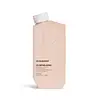What's inside
What's inside
 Key Ingredients
Key Ingredients

No key ingredients
 Benefits
Benefits

No benefits
 Concerns
Concerns

 Ingredients Side-by-side
Ingredients Side-by-side

Water
Skin ConditioningSodium Laureth Sulfate
CleansingCoco-Betaine
CleansingSodium Lauryl Sulfate
CleansingSodium Chloride
MaskingGlycol Distearate
EmollientHexylene Glycol
EmulsifyingParfum
MaskingAminopropyl Triethoxysilane
Acrylates Copolymer
Hydroxypropyl Guar Hydroxypropyltrimonium Chloride
Alcohol Denat.
AntimicrobialPolyquaternium-30
Citric Acid
BufferingBenzyl Alcohol
PerfumingLinalool
PerfumingHexyl Cinnamal
PerfumingMagnesium Nitrate
Alpha-Isomethyl Ionone
PerfumingLimonene
PerfumingMethylchloroisothiazolinone
PreservativeMagnesium Chloride
Methylisothiazolinone
PreservativeSodium Hydroxide
BufferingWater, Sodium Laureth Sulfate, Coco-Betaine, Sodium Lauryl Sulfate, Sodium Chloride, Glycol Distearate, Hexylene Glycol, Parfum, Aminopropyl Triethoxysilane, Acrylates Copolymer, Hydroxypropyl Guar Hydroxypropyltrimonium Chloride, Alcohol Denat., Polyquaternium-30, Citric Acid, Benzyl Alcohol, Linalool, Hexyl Cinnamal, Magnesium Nitrate, Alpha-Isomethyl Ionone, Limonene, Methylchloroisothiazolinone, Magnesium Chloride, Methylisothiazolinone, Sodium Hydroxide
Water
Skin ConditioningSodium Methyl 2-Sulfolaurate
CleansingSodium Cocoyl Isethionate
CleansingCocamidopropyl Hydroxysultaine
CleansingDisodium 2-Sulfolaurate
CleansingPEG-2 Cocamide
EmulsifyingCocamidopropyl Betaine
CleansingPEG-150 Distearate
EmulsifyingPanthenol
Skin ConditioningZingiber Officinale Root Extract
MaskingUrtica Dioica Extract
AstringentOleanolic Acid
Skin ConditioningAesculus Hippocastanum Seed Extract
Skin ConditioningEuterpe Oleracea Fruit Extract
Bambusa Vulgaris Leaf/Stem Extract
HumectantOryza Sativa Bran Oil
EmollientSilk Amino Acids
HumectantRice Amino Acids
Skin ConditioningKeratin Amino Acids
Skin ConditioningAloe Barbadensis Leaf Juice
Skin ConditioningCreatine
Skin ConditioningApigenin
AntioxidantBiotinoyl Tripeptide-1
Lactic Acid
BufferingZinc Picolinate
SoothingGlycerin
HumectantIsopropyl Alcohol
SolventButylene Glycol
HumectantPropanediol
SolventButyloctanol
HumectantDicetyldimonium Chloride
EmulsifyingSilicone Quaternium-16
Skin ConditioningPPG-26-Buteth-26
Skin ConditioningGlycol Distearate
EmollientGuar Hydroxypropyltrimonium Chloride
Skin ConditioningUndeceth-11
EmollientPEG-120 Methyl Glucose Trioleate
CleansingSteareth-4
EmulsifyingPEG-40 Hydrogenated Castor Oil
EmulsifyingUndeceth-5
EmulsifyingPolyquaternium-7
Polyquaternium-10
Disodium EDTA
Trisodium Hedta
Phenoxyethanol
PreservativeEthylhexylglycerin
Skin ConditioningChlorphenesin
AntimicrobialSorbic Acid
PreservativeBenzoic Acid
MaskingPotassium Sorbate
PreservativeSodium Benzoate
MaskingLactobacillus Ferment
Skin ConditioningLeuconostoc/Radish Root Ferment Filtrate
AntimicrobialIodopropynyl Butylcarbamate
PreservativeCitric Acid
BufferingParfum
MaskingBenzyl Benzoate
AntimicrobialBenzyl Salicylate
PerfumingHydroxycitronellal
PerfumingWater, Sodium Methyl 2-Sulfolaurate, Sodium Cocoyl Isethionate, Cocamidopropyl Hydroxysultaine, Disodium 2-Sulfolaurate, PEG-2 Cocamide, Cocamidopropyl Betaine, PEG-150 Distearate, Panthenol, Zingiber Officinale Root Extract, Urtica Dioica Extract, Oleanolic Acid, Aesculus Hippocastanum Seed Extract, Euterpe Oleracea Fruit Extract, Bambusa Vulgaris Leaf/Stem Extract, Oryza Sativa Bran Oil, Silk Amino Acids, Rice Amino Acids, Keratin Amino Acids, Aloe Barbadensis Leaf Juice, Creatine, Apigenin, Biotinoyl Tripeptide-1, Lactic Acid, Zinc Picolinate, Glycerin, Isopropyl Alcohol, Butylene Glycol, Propanediol, Butyloctanol, Dicetyldimonium Chloride, Silicone Quaternium-16, PPG-26-Buteth-26, Glycol Distearate, Guar Hydroxypropyltrimonium Chloride, Undeceth-11, PEG-120 Methyl Glucose Trioleate, Steareth-4, PEG-40 Hydrogenated Castor Oil, Undeceth-5, Polyquaternium-7, Polyquaternium-10, Disodium EDTA, Trisodium Hedta, Phenoxyethanol, Ethylhexylglycerin, Chlorphenesin, Sorbic Acid, Benzoic Acid, Potassium Sorbate, Sodium Benzoate, Lactobacillus Ferment, Leuconostoc/Radish Root Ferment Filtrate, Iodopropynyl Butylcarbamate, Citric Acid, Parfum, Benzyl Benzoate, Benzyl Salicylate, Hydroxycitronellal
 Reviews
Reviews

Ingredients Explained
These ingredients are found in both products.
Ingredients higher up in an ingredient list are typically present in a larger amount.
Citric Acid is an alpha hydroxy acid (AHA) naturally found in citrus fruits like oranges, lemons, and limes.
Like other AHAs, citric acid can exfoliate skin by breaking down the bonds that hold dead skin cells together. This helps reveal smoother and brighter skin underneath.
However, this exfoliating effect only happens at high concentrations (20%) which can be hard to find in cosmetic products.
Due to this, citric acid is usually included in small amounts as a pH adjuster. This helps keep products slightly more acidic and compatible with skin's natural pH.
In skincare formulas, citric acid can:
While it can provide some skin benefits, research shows lactic acid and glycolic acid are generally more effective and less irritating exfoliants.
Most citric acid used in skincare today is made by fermenting sugars (usually from molasses). This synthetic version is identical to the natural citrus form but easier to stabilize and use in formulations.
Read more about some other popular AHA's here:
Learn more about Citric AcidGlycol Distearate serves as a pearlizing or opacifying agent in cosmetic products.
It's often included in cleansers and haircare products to give them a lustrous or shimmering appearance.
It is derived from stearic acid, a natural fatty acid commonly found in vegetable oils and animal fats.
Glycol Distearate isn't fungal acne safe.
Learn more about Glycol DistearateParfum is a catch-all term for an ingredient or more that is used to give a scent to products.
Also called "fragrance", this ingredient can be a blend of hundreds of chemicals or plant oils. This means every product with "fragrance" or "parfum" in the ingredients list is a different mixture.
For instance, Habanolide is a proprietary trade name for a specific aroma chemical. When used as a fragrance ingredient in cosmetics, most aroma chemicals fall under the broad labeling category of “FRAGRANCE” or “PARFUM” according to EU and US regulations.
The term 'parfum' or 'fragrance' is not regulated in many countries. In many cases, it is up to the brand to define this term.
For instance, many brands choose to label themselves as "fragrance-free" because they are not using synthetic fragrances. However, their products may still contain ingredients such as essential oils that are considered a fragrance by INCI standards.
One example is Calendula flower extract. Calendula is an essential oil that still imparts a scent or 'fragrance'.
Depending on the blend, the ingredients in the mixture can cause allergies and sensitivities on the skin. Some ingredients that are known EU allergens include linalool and citronellol.
Parfum can also be used to mask or cover an unpleasant scent.
The bottom line is: not all fragrances/parfum/ingredients are created equally. If you are worried about fragrances, we recommend taking a closer look at an ingredient. And of course, we always recommend speaking with a professional.
Learn more about ParfumWater. It's the most common cosmetic ingredient of all. You'll usually see it at the top of ingredient lists, meaning that it makes up the largest part of the product.
So why is it so popular? Water most often acts as a solvent - this means that it helps dissolve other ingredients into the formulation.
You'll also recognize water as that liquid we all need to stay alive. If you see this, drink a glass of water. Stay hydrated!
Learn more about Water